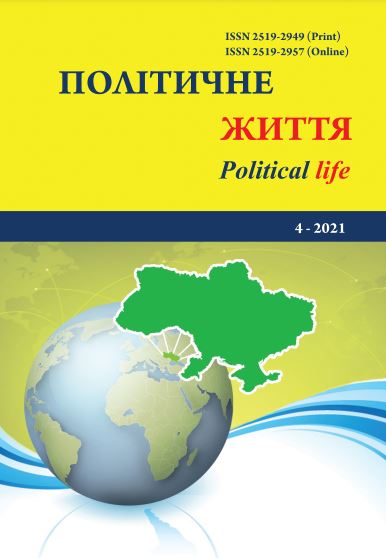Asymmetry of power in international relations
DOI:
https://doi.org/10.31558/2519-2949.2021.4.12Keywords:
asymmetry; power; international relations; state; power-force resource; subjectAbstract
The article is devoted to a comprehensive study of the asymmetry of power in a complex system of international relations, which is characterized by a particularly high degree of global stratification, integration and asymmetric interdependence. Uneven distribution of power, increasing the number of asymmetric threats at the beginning of the XXI century, limited degree of study of the research topic in the domestic literature highlights the need to understand the asymmetry of power in international relations. In determining the power of the state in world politics, the determining factor is the material and power factor, which is clearly manifested at the present stage of development. Asymmetry of power – uneven distribution of power between participants in international relations leads to the dominance of several states that have higher indices of power than others. Dominance is manifested in various areas – from military to economic and cultural. Inequality of power creates an asymmetry of interaction. The strategy of the state’s behavior in the international arena depends on the level of power. The ratio of total power capabilities between actors can change, which leads to an increase in the power of some actors and the decline of power of others. The asymmetric distribution of power leads to the formation of rights and rules governing the interaction between states, in which states compete for the preservation of the geopolitical status quo and their global influence. Despite the growing role of soft power components, the power continues to play a leading role in the international arena and to influence the format of relations in various areas of cooperation. In general, asymmetry can lead to stability and not cause tension in relations, which contradicts the current theory of international relations on asymmetric relations between states.
References
Кононенко С. Теоретичні передумови розуміння сучасної багатополярності. Політичний менеджмент. 2013. № 59. С. 145–153.
Симония Н. А. Глобализация, структурный кризис и мировое лидерство. Мифы и реальность. Москва: Библиотека «Международной жизни», 2013. 88 с.
Цыганков П. А. Теория международных отношений: Хрестоматия. Москва: Гардарики, 2002. 400 с.
Aron R. Paix et Guerre entre les nations. Calmann-Lévy, Paris, 1962. 797 p.
Arreguín-Toft I. How the Weak Win Wars: A Theory of Asymmetric Conflict. New York, NY: Cambridge University Press, 2005. 274 р.
Dahl R. The Concept of Power. Behavioral Science. 1957. Vol. 2, no. 3. p. 201–215.
Donnelly J. Realism and International Relations. Cambridge University Press, 2000. 231 p.
Gilpin R. G. The Richness of the Tradition of Political Realism. Neorealism and its Critics. New York, NY: Columbia University Press, 1986. p. 301–322.
Gilpin R. A Realist Perspective on International Governance. Globalization: Power, Authority, and Governance, edited by David Held and Anthony McGrew, 2002. p. 237–248.
Gray C. World Politics as usual after September 11. Worlds in Collision: Terror and Future of Global Order / Ed. by K.Booth and T.Dunn. Basingstoke, 2002. p. 226–234.
Herz J. The Nation-State and the Crisis of World Politics: Essays on International Politics in the Twentieth Century. New York: D. McKa, 1976. 307 p.
Jervis R. Cooperation under the security dilemma. World politics. Baltimore, Md., 1978. N 2. p. 167–214.
Keohane R. O. After Hegemony: Cooperation and Discord in the World Political Economy. Princeton: Princeton University Press, 2005. 320 p.
Mearsheimer John J. The Tragedy of Great Power Politics. New York, NY: W.W. Norton, 2001. URL: https://samuelbhfauredotcom.files.wordpress.com/2015/10/s2-mearsheimer-2001.pdf (accessed 11.03.2020).
Morgenthau H. J. Politics Among Nations: the Struggle for Power and Peace. N.Y.: Knopf, 1950. 618 p.
Nye J. S. Peace in parts: Integration and conflict in regional organization. Boston: Little, Brown, 1971. 136 p.
Pfetsch Frank R. Power in International Negotiations: Symmetry and Asymmetry. Négociations. 2011 (n 16). URL: https://www.cairn.info/revue-negociations-2011-2-page-39.htm (accessed 12.02.2020)
Waltz K.N. Neorealism and its Critics. N.Y.: Columbia univ. press, 1986. 378 p.
Womack B. Asymmetry Theory and China’s Concept of Multipolarity. Journal of Contemporary China. 2004. 13(39), May. URL: https://pdfs.semanticscholar.org/ed61/fecb11d32e3eda43377b76c31d4799483056.pdf (accessed 10.03.2020).
Womack B. Asymmetry and International Relationships. New York: Cambridge University Press, 2016. 220 p.

